1. Overview
Edgar Dean "Ed" Mitchell (September 17, 1930 - February 4, 2016) was an American Navy officer and aviator, test pilot, aeronautical engineer, ufologist, and NASA astronaut. He is best known for his pivotal role as the Lunar Module Pilot of Apollo 14 in 1971, which made him the sixth person to walk on the Moon. During his nine hours on the lunar surface in the Fra Mauro Highlands region, he actively participated in scientific experiments and collected lunar samples. After retiring from NASA and the U.S. Navy, Mitchell pursued a distinctive post-NASA career focused on consciousness studies and parapsychology, notably founding the Institute of Noetic Sciences (IONS) to research these phenomena. He also became a prominent public figure in the UFO community, asserting the reality of extraterrestrial life and alleging government cover-ups regarding alien contact, views that garnered both significant public attention and considerable controversy from the scientific community.
2. Early life and education
Edgar Mitchell's formative years were significantly shaped by his family's background, his upbringing in New Mexico, and a rigorous academic and military education, which collectively laid the groundwork for his distinguished career as an astronaut and later for his explorations into unconventional fields.
2.1. Childhood and family background
Mitchell was born on September 17, 1930, in Hereford, Texas. His parents were Joseph Thomas Mitchell (1910-1967) and Ollidean Margaret Mitchell (née Arnold; 1911-1977). He had three siblings: Joyce Alyene, who died in infancy in 1933, Sandra Jo (1934-1988), and Jay Neely "Coach" (1937-2013). Jay, his younger brother, was a member of the inaugural graduating class of the United States Air Force Academy in 1959 and served as a pilot with the United States Air Force (USAF), achieving the rank of colonel. Mitchell came from a ranching family that relocated to New Mexico during the Great Depression, and he regarded Artesia, New Mexico (located near Roswell) as his hometown. He developed an early passion for aviation, learning to fly at the age of 13 and receiving his private pilot license at 16. During his youth, Mitchell was an active member of the Boy Scouts of America, where he attained the rank of Life Scout, the organization's second-highest achievement. He was also a member of DeMolay International, an appendant body of the Masonic Fraternity, and was later inducted into its Hall of Fame. Mitchell was a member of Artesia Lodge #29 in New Mexico. For leisure, he enjoyed handball, tennis, and swimming, and his hobbies included scuba diving and soaring.
2.2. Education and academic achievements
Mitchell graduated from Artesia High School in 1948. He pursued higher education, earning a Bachelor of Science degree in industrial management from the Carnegie Institute of Technology (now Carnegie Mellon University) in 1952. During his time there, he was a member of the Kappa Sigma fraternity. That same year, he joined the United States Navy and completed basic training at San Diego Recruit Depot.
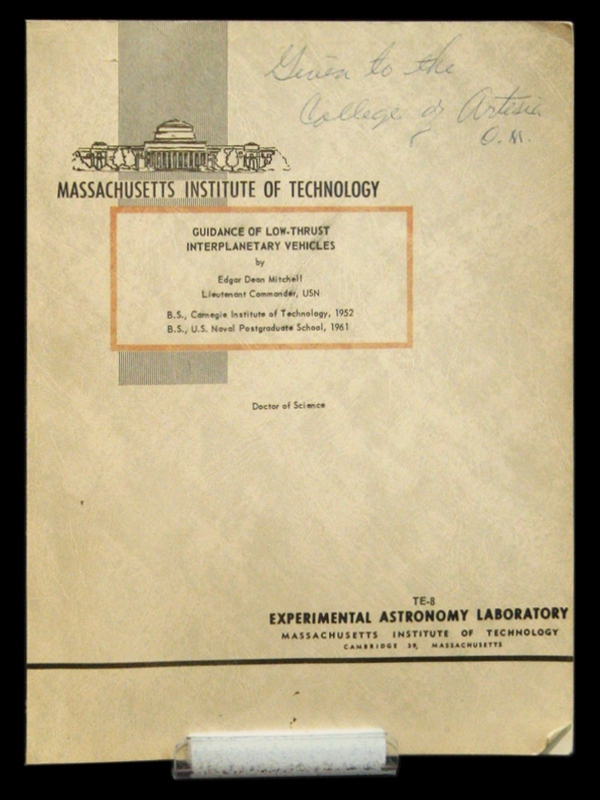
While serving on active duty in the Navy, he continued his academic pursuits, earning a second bachelor's degree in aeronautical engineering from the U.S. Naval Postgraduate School in 1961. He further advanced his education by obtaining a Doctor of Science degree in aeronautics and astronautics from the Massachusetts Institute of Technology (MIT) in 1964.
3. NASA career
Mitchell's NASA career was defined by his selection into the astronaut corps and his singular, yet historically significant, spaceflight as the Lunar Module Pilot on Apollo 14.
3.1. Astronaut selection and preparation
Mitchell was selected in 1966 as part of NASA's fifth astronaut group. His initial assignments included serving on the support crew for Apollo 9. He was then designated as the backup Lunar Module Pilot for Apollo 10. This progression typically would have placed him in rotation for the Apollo 13 mission; however, his crew was ultimately switched to Apollo 14. This change was made to allow Commander Alan Shepard, who had been grounded due to a medical problem since the Gemini program, more time for training.
During the critical Apollo 13 crisis in 1970, Mitchell was an integral part of the Apollo 13 Mission Operations Team. His contributions to the effort to bring the crew back safely earned him the Presidential Medal of Freedom from President Richard M. Nixon. Specifically, he worked extensively in an Apollo simulator, helping to determine how to control the attitude of the Lunar Module when it was attached to an inert and damaged Apollo Command/Service Module. This was a unique challenge as the usual procedure involved the Service Module controlling the Lunar Module.
3.2. Apollo 14 mission
Mitchell's sole spaceflight was as the Lunar Module Pilot on Apollo 14. He landed with Commander Alan Shepard aboard the Lunar Module Antares on February 5, 1971, in the hilly upland Fra Mauro Highlands region of the Moon. They remained on the lunar surface for 33 hours, during which they deployed and activated lunar surface scientific equipment and experiments, and collected nearly 100 lb (100 lb) of lunar samples for return to Earth.
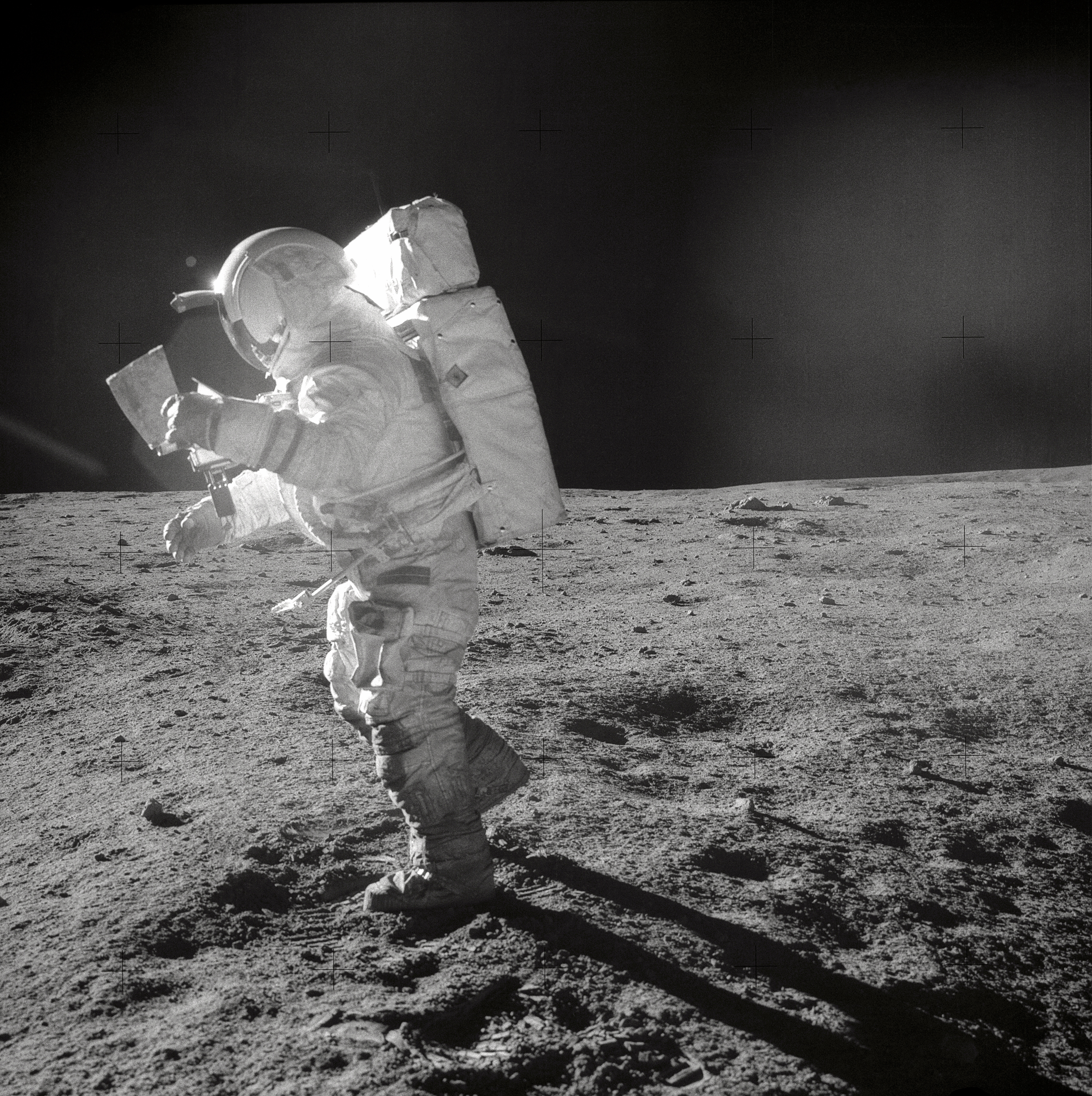
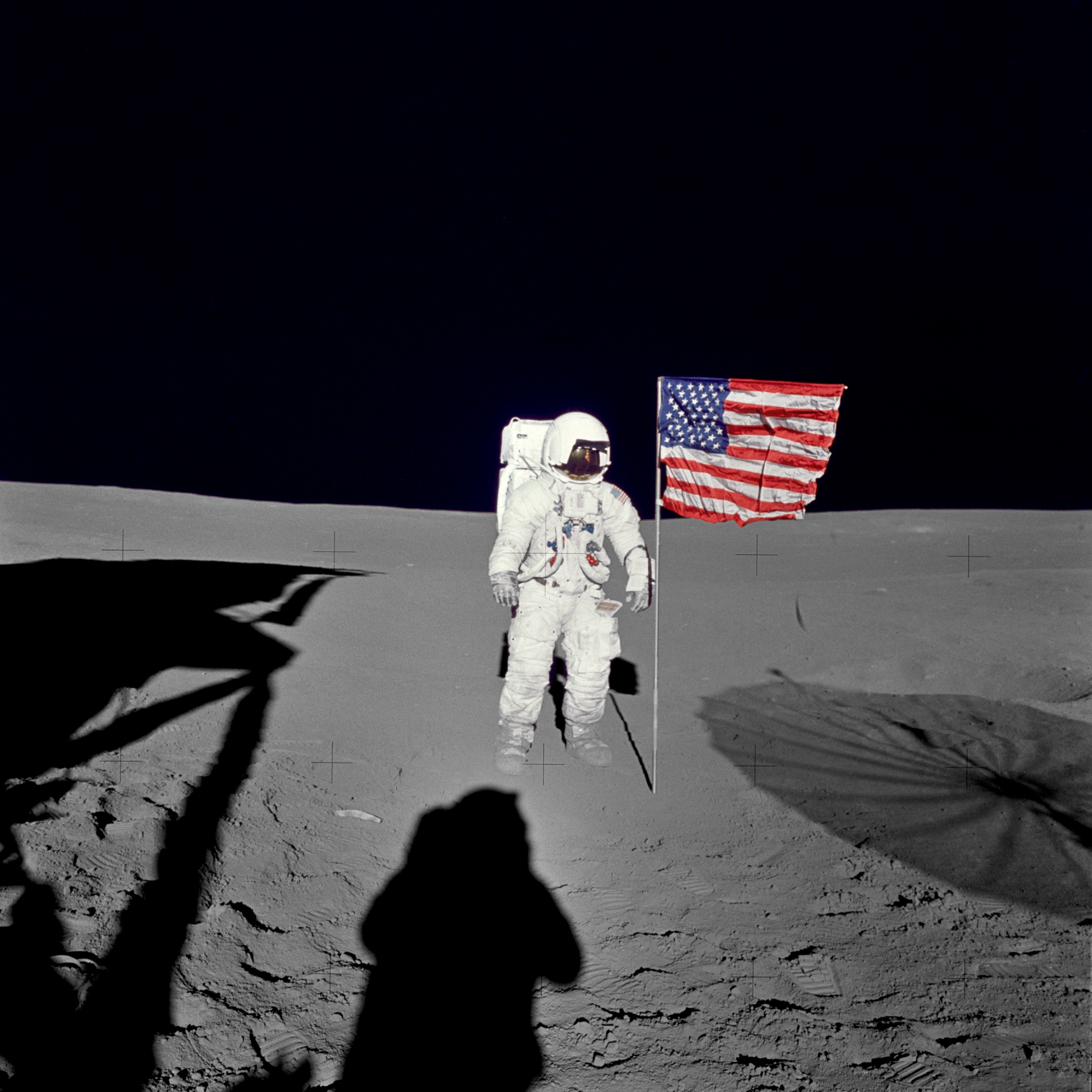
Other significant achievements of the Apollo 14 mission included: the only use of the Mobile Equipment Transporter (MET), a two-wheeled cart designed to carry tools and samples across the lunar surface; the first successful use of color television equipped with a new Vidicon tube, which greatly enhanced the quality of broadcasts from the Moon; the longest distance traversed on foot on the lunar surface; the largest payload placed in lunar orbit; the first use of shortened lunar orbit rendezvous techniques; and the first extensive orbital science period conducted during the Command/Service Module (CSM) solo operations, after the lunar module had departed. During his time on the Moon, Mitchell took numerous photographs, including one iconic image of Shepard raising the American flag, where Mitchell's own shadow is cast prominently over the lunar surface near the flag. This photo was later featured in Popular Science magazine's gallery of the "best astronaut selfies."
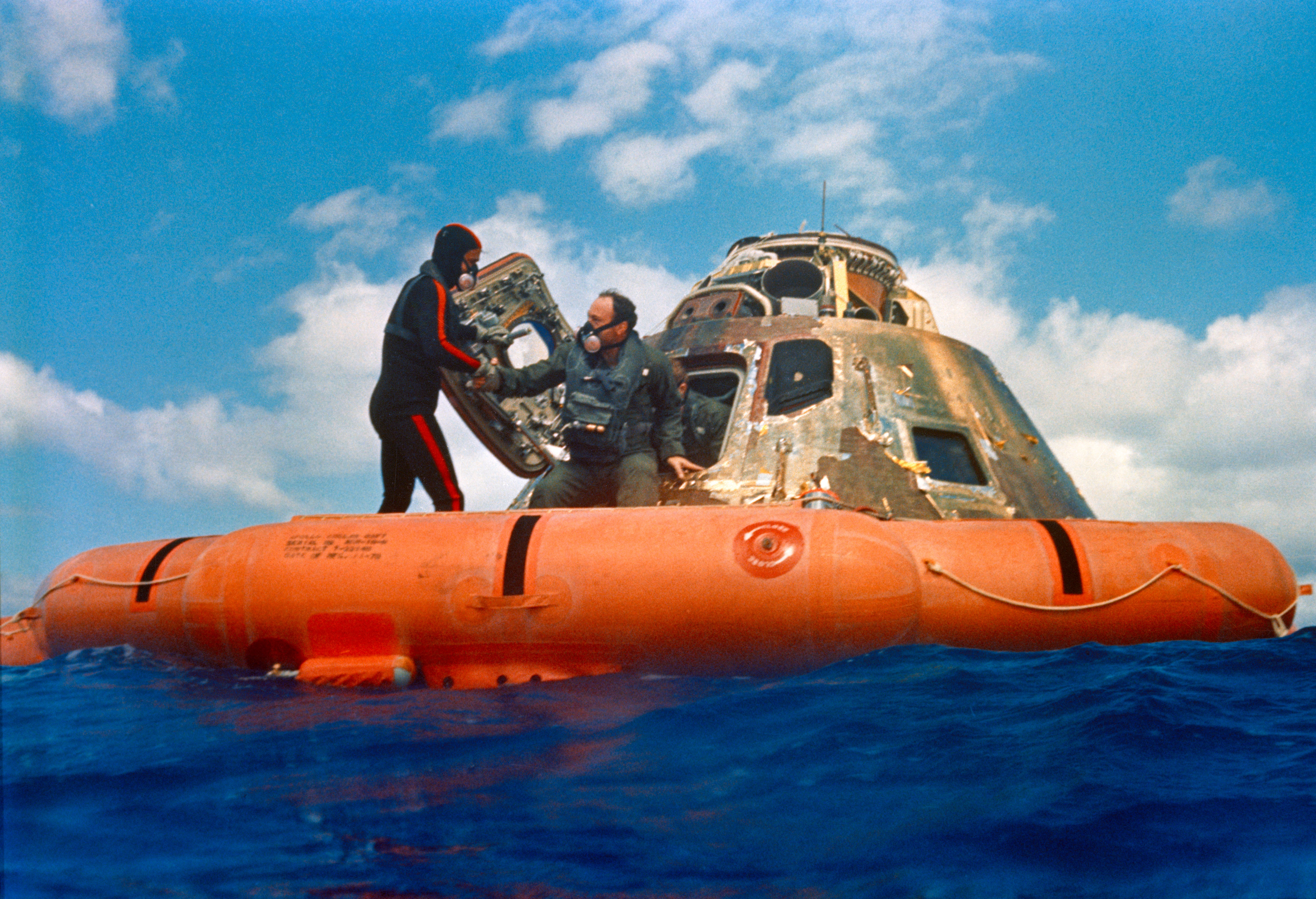
3.3. Spaceflight experience and the 'overview effect'
Upon completing his first and only space flight, Mitchell logged a total of 216 hours and 42 minutes in space. Following Apollo 14, he was designated to serve as the backup Lunar Module Pilot for Apollo 16.
During his return journey to Earth on the Apollo 14 flight, Mitchell reported a profound psychological experience, which he described as a savikalpa samādhi. This experience is akin to what is commonly referred to as the "overview effect"-a cognitive shift reported by some astronauts when viewing Earth from space, leading to a feeling of interconnectedness and a deeper appreciation for the planet. Mitchell famously articulated this experience, stating, "You develop an instant global consciousness, a people orientation, an intense dissatisfaction with the state of the world, and a compulsion to do something about it. From out there on the moon, international politics look so petty. You want to grab a politician by the scruff of the neck and drag him a quarter of a million miles out and say, 'Look at that, you son of a bitch.'"
4. Post-NASA career
After his retirement from NASA and the U.S. Navy, Mitchell embarked on a distinctive second career, dedicating himself to the exploration of consciousness, parapsychology, and highly unconventional subjects, including unidentified flying objects and extraterrestrial life.
4.1. Founding and activities of the Institute of Noetic Sciences (IONS)
Mitchell retired from NASA and the U.S. Navy with the rank of captain in October 1972. Immediately following his retirement, he founded Edgar D. Mitchell & Associates in Monterey, California, a "commercial organization promoting ecologically-pure products and services designed to alleviate planetary problems." After relocating to Atherton, California, Mitchell became the founding chairman of the Institute of Noetic Sciences (IONS) in Palo Alto, California, which he established in 1973. The primary purpose of IONS was to conduct research into consciousness and other "related phenomena." Mitchell expressed his vision for the institute, stating towards the end of his life, "Science and religion have lived on opposite sides of the street now for hundreds of years... So here we are, in the twenty-first century, trying to put two faces of reality-the existence face and the intelligence or conscious face-into the same understanding. Body and mind, physicality and consciousness belong to the same side of reality."
Journalist Annie Jacobsen asserted that Mitchell's Mind Science Institute, an organization based in Los Angeles, California, which was eventually subsumed by the Institute of Noetic Sciences, was purportedly used by the Central Intelligence Agency (CIA). This alleged arrangement served as a clandestine channel for payments to Andrija Puharich and Uri Geller during the period in 1972 when Geller was being evaluated by an SRI International research group, led by Harold E. Puthoff and Russell Targ. In 1976, Mitchell reportedly attempted to secure additional funding for the SRI group's remote viewing research during a private meeting with then-Director of Central Intelligence George H. W. Bush, whom Mitchell knew socially. Although Bush declined the request, citing post-Watergate investigations of the intelligence community, he suggested the pursuit of military sponsorship. This indirectly led to the formation of the Stargate Project in 1978, an intelligence program that investigated psychic phenomena.
From 1974 to 1978, Mitchell served as president of the Palm Beach, Florida-based Edgar Mitchell Corporation. In 1975, he moved to nearby Lantana, Florida, where he resided for the remainder of his life. He also co-founded the Association of Space Explorers in 1983 and later held the position of chairman of the Mitchell Communications Company. In a 1997 interview for NASA's oral history program, Mitchell reflected on his motivation for joining the space program, stating, "After Kennedy announced the moon program, that's what I wanted, because it was the bear going over the mountain to see what he could see, and what could you learn, and I've been devoted to that, to exploration, education, and discovery since my earliest years, and that's what kept me going."
4.2. Research on consciousness, parapsychology, and spirituality
Mitchell's profound experience during his spaceflight sparked his lifelong interest in consciousness and paranormal phenomena. While en route back to Earth during the Apollo 14 mission, he claimed to have conducted private ESP experiments with friends on Earth. The alleged results of these experiments were later published in the Journal of Parapsychology in 1971. His 1996 book, The Way of the Explorer, chronicles his personal journey into mysticism and space, in which he proposed a dyadic model of reality, aiming to bridge the material and mystical worlds. Mitchell served as the Advisory Board Chairman of the Institute for Cooperation in Space, co-founded by Carol Rosin, and was also a member of the INREES (Institute for Research of Extraordinary Experiences), an organization focused on researching extraordinary human experiences.
4.3. Views on UFOs and extraterrestrial life
Edgar Mitchell became a vocal proponent of the belief in UFOs and extraterrestrial life, often asserting that governments had suppressed evidence of their existence.
4.3.1. Claims about UFOs and alien contact
Mitchell publicly stated his strong conviction, asserting he was "90 percent sure that many of the thousands of unidentified flying objects, or UFOs, recorded since the 1940s, belong to visitors from other planets." He appeared in a 1996 interview on Dateline NBC, where he claimed to have met with officials from three different countries who asserted they had personal encounters with extraterrestrials. Mitchell opined that the evidence for such "alien" contact was "very strong" and had been "classified" by governments. He further claimed that UFOs had provided "sonic engineering secrets" that proved beneficial to the U.S. government. According to Mitchell, these extraterrestrial beings are typically small with large heads and eyes, and are friendly towards humanity, suggesting that if they were hostile, humans would no longer exist. On July 23, 2008, during an interview on Kerrang Radio, Mitchell reiterated his belief that the Roswell crash was a genuine event involving alien craft and that aliens had contacted humans multiple times. He declared, "I happen to have been privileged enough to be in on the fact that we've been visited on this planet, and the UFO phenomenon is real." In an interview for AskMen published on March 6, 2014, Mitchell clarified that he had never personally seen a UFO. In 2015, Mitchell stated in an interview with the Daily Mirror that extraterrestrials "had been attempting to keep us from going to war [with Russia]] and help create peace on Earth." He also claimed that "White Sands was a testing ground for atomic weapons-and that's what the extraterrestrials were interested in. They wanted to know about our military capabilities."
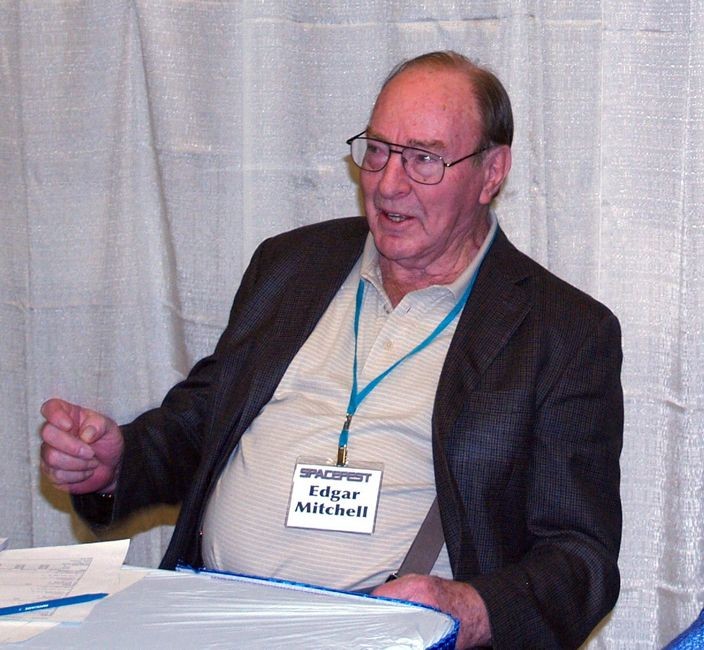
4.3.2. Government cover-up theories
Mitchell was a fervent advocate of the theory that governments had actively concealed the truth about alien visitations and the existence of extraterrestrial beings' bodies. He asserted that governments were covering up alien visitations and the existence of alien bodies in locations such as Roswell, New Mexico. In a 2004 interview with the St. Petersburg Times, he claimed that a "cabal of insiders" within the U.S. government was studying recovered alien bodies, and that this group had ceased briefing U.S. Presidents on the matter after John F. Kennedy. He underscored his certainty by stating, "We all know that UFOs are real; now the question is where they come from." He also claimed to have received confirmation of the Roswell incident from an unnamed, now deceased, intelligence officer at the Pentagon. Despite these strong assertions, in his 2014 AskMen interview, Mitchell admitted that any statements he made about a "worldwide cabal" covering up UFOs were "just speculation on my part."
In response to Mitchell's claims, a spokesman for NASA explicitly distanced the agency from his views. On the Skeptoid Podcast with Brian Dunning, NASA stated: "NASA does not track UFOs. NASA is not involved in any sort of cover-up about alien life on this planet or anywhere in the universe. Dr Mitchell is a great American, but we do not share his opinions on this issue." NASA reaffirmed that while Mitchell was a great American, his specific views on this topic were not shared by the agency.
4.4. Remote healing and other projects
Beyond his work on consciousness and UFOs, Mitchell was involved in other unique endeavors and public statements.
4.4.1. Remote healing claims
Mitchell claimed to have experienced remote healing for a medical condition. He asserted that a teenage remote healer living in Vancouver, using the pseudonym "Adam Dreamhealer," helped him recover from kidney cancer from a distance. Mitchell stated that while he never underwent a biopsy, he "had a sonogram and MRI that was consistent with renal carcinoma." Adam reportedly worked on Mitchell remotely from December 2003 until June 2004, after which Mitchell reported that the "irregularity was gone and we haven't seen it since."
4.4.2. LSD experimentation
Mitchell's previously undisclosed experimentation with LSD was reported by writer David Jay Brown in his 2013 book, The New Science of Psychedelics: At the Nexus of Culture, Consciousness, and Spirituality. Although Mitchell favorably compared the sensations experienced during the psychedelic experience to his time in zero gravity, it remains unclear whether his use of LSD occurred before or after his Apollo 14 mission.
4.4.3. Legal dispute over Apollo 14 camera
On June 29, 2011, the federal government of the United States filed a lawsuit against Mitchell in the United States district court in Miami, Florida. This action was taken after it was discovered that Mitchell had consigned a camera used on the Apollo 14 mission for auction at the auction house Bonhams. The litigation sought the return of the camera to NASA. Mitchell's defense was that NASA had given him the camera as a gift upon the completion of the Apollo 14 mission. Consequently, Bonhams withdrew the camera from auction. In October 2011, attorneys representing both the government and Mitchell reached a settlement agreement. Under the terms of the settlement, Mitchell agreed to return the camera to NASA, which in turn would donate it for display at the National Air and Space Museum. On September 20, 2012, the U.S. Congress enacted H.R. 4158, a law that confirmed full ownership rights of artifacts to astronauts who participated in the Apollo, Mercury, and Gemini space missions.
4.4.4. Support for global governance
Mitchell was an initial supporter of the Campaign for the Establishment of a United Nations Parliamentary Assembly. This initiative aims to establish a directly elected global parliamentary body, which Mitchell viewed as a significant step towards a "world parliament" and a form of global governance.
5. Personal life
Edgar Mitchell was married multiple times and had several children. He was married to Louise Randall from 1951 to 1972. Following their divorce, he married Anita Rettig in 1973. This marriage ended in divorce in 1984, reportedly when he began an affair with former Playboy model Sheilah Ledbetter. Mitchell was a father to two children with Louise Randall and adopted Rettig's three children. He later had another child with Sheilah Ledbetter. Anita Rettig served as chair of the Palm Beach County Republican Party, and Kimberly Mitchell, one of the daughters from his union with Rettig, served as a city commissioner in West Palm Beach, Florida. Ledbetter and Mitchell married in 1989 and divorced in 1999. Mitchell was survived by five children, nine grandchildren, and one great-grandchild.
6. Death
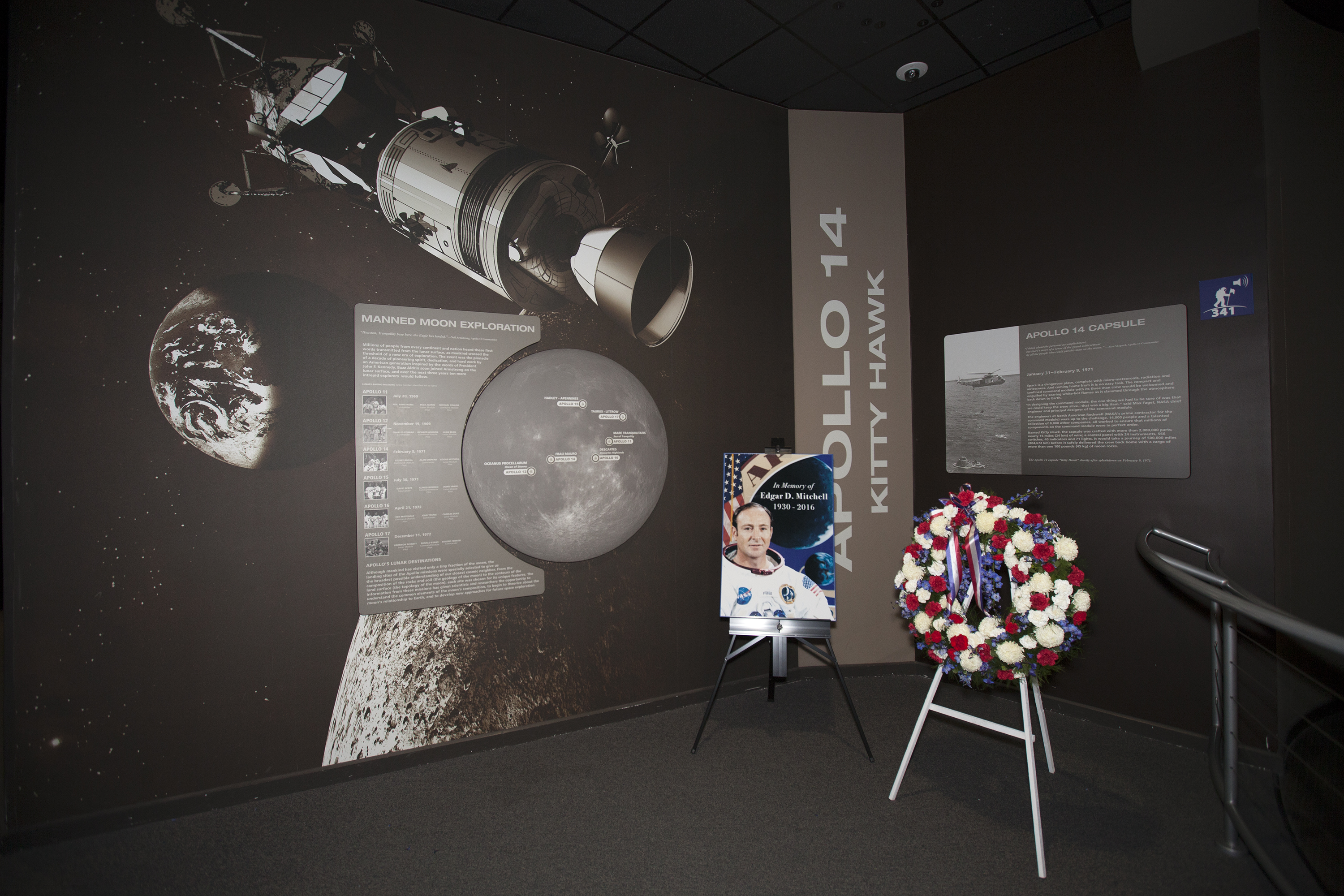
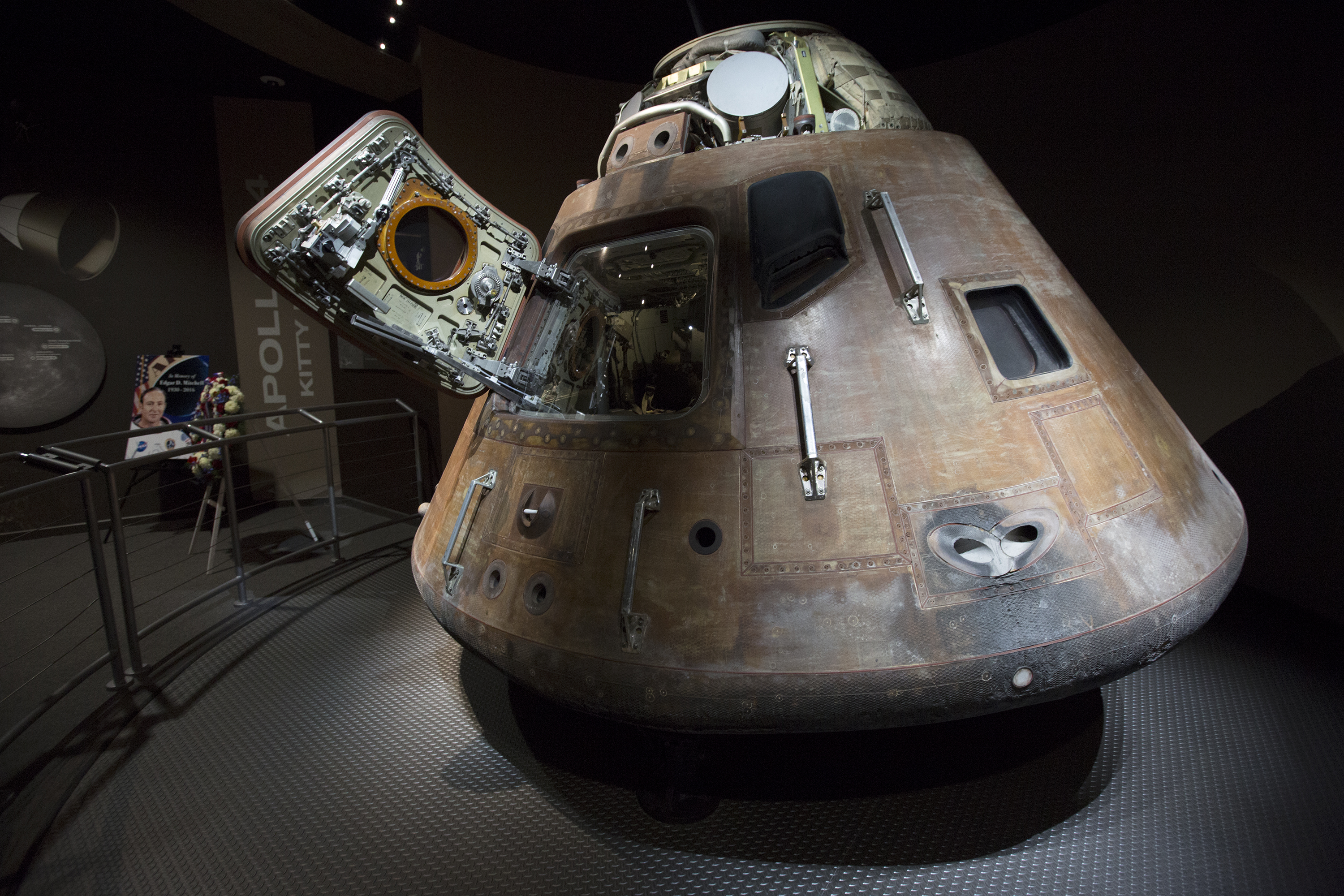
Edgar Mitchell passed away under hospice care in West Palm Beach, Florida, at the age of 85, on February 4, 2016. His death occurred on the eve of the 45th anniversary of his historic lunar landing. With the prior deaths of Stuart Roosa and Alan Shepard in the 1990s, Mitchell was the last surviving member of the Apollo 14 crew.
7. Assessment and legacy
Edgar Mitchell's legacy is characterized by his significant contributions as a lunar astronaut, coupled with his later controversial pursuits in consciousness research and advocacy for extraterrestrial disclosure.
7.1. Awards and honors
Mitchell received numerous awards and honors throughout his distinguished career:
- Presidential Medal of Freedom (1970)
- Manned Spacecraft Center Superior Achievement Award (1970)
- City of New York Gold Medal (1971)
- Arnold Air Society's John F. Kennedy Award (1971)
- Navy Astronaut Wings
- Navy Distinguished Service Medal
- NASA Distinguished Service Medal
- Air Medal
- National Defense Service Medal with bronze star
- China Service Medal
- Three NASA Group Achievement Awards
- Inducted into the International Space Hall of Fame (1979)
- Inducted into the United States Astronaut Hall of Fame on October 4, 1997, alongside 24 other Apollo astronauts.
He was also awarded honorary doctorates from:
- New Mexico State University (1971)
- Carnegie-Mellon University (1971)
- University of Akron (1979)
- Embry-Riddle University (1996)
Further recognitions included:
- American Astronautical Society's Flight Achievement Award
- Carnegie Mellon University Alumni, Outstanding Man of the Year (1972)
- Kappa Sigma, Man of the Year Award (1972)
- Adventurers Club, Gold Medal Award for Exploration
- Drexel University, Engineering and Science Award for Explorations in Consciousness (1974)
- The Explorers Club, Lowell Thomas Award for Explorations in Human Consciousness (1980)
Mitchell was a member of several professional organizations, including the American Institute of Aeronautics and Astronautics; the Society of Experimental Test Pilots; Sigma Xi; Sigma Gamma Tau; the New York Academy of Sciences; The Explorers Club; World Futures Society; and the International Platform Association. He was also an honorary member of the Radio and Television Correspondents' Association.
7.2. Criticism and controversy
Mitchell's public statements regarding UFOs, extraterrestrial life, and parapsychology drew significant criticism and controversy, particularly from mainstream scientific communities and official government agencies. NASA explicitly distanced itself from his claims, with a spokesman stating in 2008, "NASA does not track UFOs. NASA is not involved in any sort of cover-up about alien life on this planet or anywhere in the universe. Dr Mitchell is a great American, but we do not share his opinions on this issue." Mitchell himself later admitted that some of his statements about a "worldwide cabal" covering up UFOs were "just speculation on my part."
Beyond his controversial views, Mitchell was also involved in a public confrontation documented in the 2004 documentary Astronauts Gone Wild. In a climactic scene from the film, after filmmaker Bart Sibrel questioned Mitchell about various aspects of footage from the Apollo 11 mission, Mitchell and his son reportedly threatened Sibrel and his assistant.
7.3. Impact on society and science
Despite the controversies surrounding his post-NASA pursuits, Mitchell left an indelible mark on various fields. His founding of the Institute of Noetic Sciences established a formal platform for scientific inquiry into consciousness, parapsychology, and the integration of science with spiritual perspectives. His public advocacy for extraterrestrial life and government transparency on UFOs significantly influenced public discourse on these topics, contributing to the broader ufology movement. While his views were often at odds with conventional science, his unique journey from lunar explorer to a proponent of radical new ideas about reality broadened the conversation about human potential and the nature of existence.
8. In media
Edgar Mitchell's life and unique perspective have been portrayed and discussed across various media. In the 1998 HBO miniseries From the Earth to the Moon, which dramatized the Apollo missions, Mitchell was played by actor Gary Cole. He was also the subject of a chapter in Chris Wright's book No More Worlds to Conquer, which examines how individuals famous for a singular achievement navigate their lives afterward. In this chapter, Mitchell discussed at length his beliefs in extraterrestrial visitation, the power of the mind, and his conviction that his cancer had been cured through "mind means." Mitchell appeared in several documentaries, including In the Shadow of the Moon (2007), The Phoenix Lights...We Are Not Alone, and The Living Matrix (2009). The 2004 documentary Astronauts Gone Wild also featured an interview with Mitchell.
9. Books
Edgar Mitchell authored or co-authored several books that reflect his interests and philosophical perspectives:
- Psychic Exploration: A Challenge for Science (1974)
- The Way of the Explorer: An Apollo Astronaut's Journey Through the Material and Mystical Worlds (1996) - This book proposes a dyadic model of reality.
- Earthrise: My Adventures as an Apollo 14 Astronaut (2014)